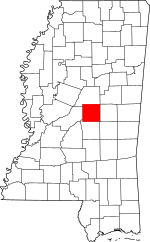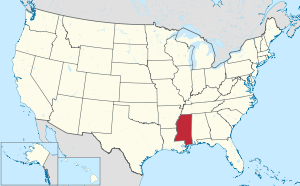Leake County, Mississippi
Leake County is a county located in the center of the U.S. state of Mississippi. As of the 2010 census, the population was 23,805.[1] Its county seat is Carthage.[2] The county is named for Walter Leake, the Governor of Mississippi from 1822 to 1825.[3]
Leake County | |
|---|---|
 Leake County Courthouse in Carthage | |
 Location within the U.S. state of Mississippi | |
 Mississippi's location within the U.S. | |
| Coordinates: 32°45′N 89°31′W | |
| Country | |
| State | |
| Founded | 1833 |
| Named for | Walter Leake |
| Seat | Carthage |
| Largest city | Carthage |
| Area | |
| • Total | 585 sq mi (1,520 km2) |
| • Land | 583 sq mi (1,510 km2) |
| • Water | 2.5 sq mi (6 km2) 0.4% |
| Population (2010) | |
| • Total | 23,805 |
| • Estimate (2018) | 22,763 |
| • Density | 41/sq mi (16/km2) |
| Time zone | UTC−6 (Central) |
| • Summer (DST) | UTC−5 (CDT) |
| Congressional district | 2nd |
| Website | www |
In 2010, the center of population of Mississippi was located in Leake County, near the town of Lena.[4]
Geography
According to the U.S. Census Bureau, the county has a total area of 585 square miles (1,520 km2), of which 583 square miles (1,510 km2) is land and 2.5 square miles (6.5 km2) (0.4%) is water.[5]
Major highways
Adjacent counties
- Attala County (north)
- Neshoba County (east)
- Scott County (south)
- Madison County (west)
National protected area
- Natchez Trace Parkway (part)
Demographics
| Historical population | |||
|---|---|---|---|
| Census | Pop. | %± | |
| 1840 | 2,162 | — | |
| 1850 | 5,533 | 155.9% | |
| 1860 | 9,324 | 68.5% | |
| 1870 | 8,496 | −8.9% | |
| 1880 | 13,146 | 54.7% | |
| 1890 | 14,803 | 12.6% | |
| 1900 | 17,360 | 17.3% | |
| 1910 | 18,298 | 5.4% | |
| 1920 | 16,973 | −7.2% | |
| 1930 | 21,803 | 28.5% | |
| 1940 | 24,570 | 12.7% | |
| 1950 | 21,610 | −12.0% | |
| 1960 | 18,660 | −13.7% | |
| 1970 | 17,085 | −8.4% | |
| 1980 | 18,790 | 10.0% | |
| 1990 | 18,436 | −1.9% | |
| 2000 | 20,940 | 13.6% | |
| 2010 | 23,805 | 13.7% | |
| Est. 2018 | 22,763 | [6] | −4.4% |
| U.S. Decennial Census[7] 1790-1960[8] 1900-1990[9] 1990-2000[10] 2010-2013[1] | |||
As of the 2010 United States Census, there were 23,805 people living in the county. 49.5% were White, 40.6% Black or African American, 6.0% Native American, 0.2% Asian, 2.8% of some other race and 0.8% of two or more races. 4.3% were Hispanic or Latino (of any race).
As of the census[11] of 2000, there were 20,940 people, 7,611 households, and 5,563 families living in the county. The population density was 36 people per square mile (14/km²). There were 8,585 housing units at an average density of 15 per square mile (6/km²). The racial makeup of the county was 56.14% White, 37.42% Black or African American, 4.56% Native American, 0.15% Asian, 0.03% Pacific Islander, 1.14% from other races, and 0.57% from two or more races. 2.10% of the population were Hispanic or Latino of any race.
There were 7,611 households out of which 34.30% had children under the age of 18 living with them, 52.20% were married couples living together, 16.50% had a female householder with no husband present, and 26.90% were non-families. 24.30% of all households were made up of individuals and 11.70% had someone living alone who was 65 years of age or older. The average household size was 2.65 and the average family size was 3.13. In the county, the population was spread out with 26.90% under the age of 18, 10.10% from 18 to 24, 27.00% from 25 to 44, 21.70% from 45 to 64, and 14.30% who were 65 years of age or older. The median age was 35 years. For every 100 females there were 98.00 males. For every 100 females age 18 and over, there were 94.20 males.
The median income for a household in the county was $27,055, and the median income for a family was $32,147. Males had a median income of $27,367 versus $18,307 for females. The per capita income for the county was $13,365. About 18.10% of families and 23.30% of the population were below the poverty line, including 31.90% of those under age 18 and 23.90% of those age 65 or over.
Government and infrastructure
The county is quite rural, with Carthage the only city and three towns.
The Mississippi Department of Corrections contracted for development of the Walnut Grove Youth Correctional Facility, which opened in 2001 in the town of Walnut Grove.[12] The facility was operated by the private Management and Training Corporation (MTC).[13]
By 2006, the Town of Walnut Grove annexed the land of the prison, resulting in an apparent increase in population, which was chiefly associated with prisoners.[14] MTC was repeatedly cited for problems with poor treatment of prisoners, and abuses within the facility. The state closed it in 2016.[15]
Education
Leake County is served by the Leake County School District and East Central Community College, including Carthage Career Advancement Center, in Leake County and operated by East Central Community College.
Racial segregation
Schools in Leake County are effectively segregated by race. Most White students attend private schools while Black and Hispanic children attend the local public schools.
| School | Total Students | White Students | Black Students | Hispanic Students | Note |
|---|---|---|---|---|---|
| Leake County | 24,000 | 56% | 37% | 2% | 2010 Census |
| Leake Academy (Private) | 578 | 571 (99%) | 0 (0%) | 3 (>1%) | [16] |
| Leake Central High School(Public) | 562 | 132 (20%) | 373 (66%) | 57 (10%) | NOTE |
Politics
| Year | Republican | Democratic | Third parties |
|---|---|---|---|
| 2016 | 56.6% 4,782 | 42.4% 3,584 | 1.0% 83 |
| 2012 | 54.1% 4,863 | 45.4% 4,079 | 0.5% 41 |
| 2008 | 55.0% 5,148 | 44.4% 4,151 | 0.6% 60 |
| 2004 | 60.4% 4,962 | 39.1% 3,212 | 0.5% 40 |
| 2000 | 59.2% 4,114 | 40.2% 2,793 | 0.7% 45 |
| 1996 | 47.6% 3,017 | 45.8% 2,902 | 6.6% 419 |
| 1992 | 50.6% 3,943 | 42.8% 3,333 | 6.6% 510 |
| 1988 | 59.9% 4,168 | 40.0% 2,787 | 0.1% 8 |
| 1984 | 62.0% 4,663 | 37.9% 2,845 | 0.1% 8 |
| 1980 | 46.8% 3,624 | 52.1% 4,033 | 1.1% 81 |
| 1976 | 45.4% 2,952 | 52.5% 3,415 | 2.2% 141 |
| 1972 | 79.1% 4,217 | 19.8% 1,053 | 1.1% 59 |
| 1968 | 7.2% 453 | 20.5% 1,295 | 72.3% 4,568 |
| 1964 | 96.2% 4,343 | 3.8% 170 | |
| 1960 | 8.8% 286 | 29.3% 953 | 61.9% 2,011 |
| 1956 | 7.3% 220 | 82.5% 2,475 | 10.1% 304 |
| 1952 | 18.4% 603 | 81.6% 2,667 | |
| 1948 | 0.5% 12 | 7.0% 180 | 92.6% 2,392 |
| 1944 | 0.9% 24 | 99.2% 2,800 | |
| 1940 | 0.6% 17 | 99.3% 2,802 | 0.1% 4 |
| 1936 | 0.3% 8 | 99.3% 2,566 | 0.4% 10 |
| 1932 | 0.7% 14 | 98.8% 1,903 | 0.5% 9 |
| 1928 | 11.1% 212 | 88.9% 1,695 | 0.0% 0 |
| 1924 | 3.7% 48 | 96.3% 1,255 | |
| 1920 | 9.9% 121 | 88.1% 1,082 | 2.0% 25 |
| 1916 | 2.1% 31 | 96.1% 1,434 | 1.9% 28 |
| 1912 | 1.1% 11 | 86.9% 910 | 12.0% 126 |
Communities
City
- Carthage (county seat)
Towns
- Lena
- Sebastopol (mostly in Scott County)
- Walnut Grove
Census-designated places
See also
References
- "State & County QuickFacts". United States Census Bureau. Archived from the original on June 7, 2011. Retrieved September 4, 2013.
- "Find a County". National Association of Counties. Retrieved 2011-06-07.
- Gannett, Henry (1905). The Origin of Certain Place Names in the United States. U.S. Government Printing Office. p. 183.
- "Centers of Population by State: 2010". United States Census Bureau. Archived from the original on January 3, 2014. Retrieved November 6, 2014.
- "2010 Census Gazetteer Files". United States Census Bureau. August 22, 2012. Archived from the original on September 28, 2013. Retrieved November 6, 2014.
- "Population and Housing Unit Estimates". Retrieved November 9, 2019.
- "U.S. Decennial Census". United States Census Bureau. Retrieved November 6, 2014.
- "Historical Census Browser". University of Virginia Library. Retrieved November 6, 2014.
- "Population of Counties by Decennial Census: 1900 to 1990". United States Census Bureau. Retrieved November 6, 2014.
- "Census 2000 PHC-T-4. Ranking Tables for Counties: 1990 and 2000" (PDF). United States Census Bureau. Retrieved November 6, 2014.
- "U.S. Census website". United States Census Bureau. Retrieved 2008-01-31.
- "Five Private Prisons Archived 2012-10-13 at the Wayback Machine." Mississippi Department of Corrections. Retrieved on November 21, 2010.
- "Walnut Grove Correctional Facility" (PDF). Management and Training Corporation. Archived from the original (PDF) on 24 December 2012. Retrieved 24 March 2013.
- "Walnut Grove Archived 2014-04-19 at WebCite." First Impressions. Mississippi State University, February 2008. 0 (3/21). Retrieved on August 14, 2010. "Looking at the MDA profile, the population growth is impressive (year 2000 – 488, year 2006 – 1,424). However, we learned that most of this population growth has been due to the location and annexation of the Walnut Grove Youth Correctional Facility."
- Wiliams, Timothy (16 September 2016). "Privately Run Mississippi Prison, Called a Scene of Horror, is Shut Down". New York Times. Retrieved 16 September 2016.
- "Leake Academy". National Center for Educational Statistics. US Department of Education. Retrieved 15 June 2019.
- Leip, David. "Dave Leip's Atlas of U.S. Presidential Elections". uselectionatlas.org. Retrieved 2018-03-04.
.svg.png)